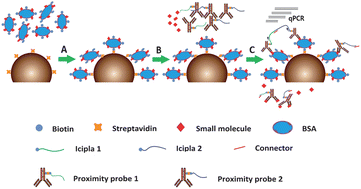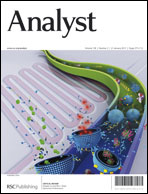The development of an indirect competitive immunomagnetic-proximity ligation assay for small-molecule detection†
Abstract
The development of an indirect competitive immunomagnetic-proximity ligation assay (ICIPLA), which is a novel method for detecting small molecules, is described in this report. Free small molecules in samples can be detected using a proximity ligation assay (PLA); the detection is based on the proximity effect caused by a high concentration of small molecule–BSA conjugates bound to streptavidin magnetic beads. As an indirect format competitive immunoassay, the ICIPLA method has the advantage in that the quantity of monoclonal antibody (mAb) used for small-molecule detection is 8-fold lower than that required for the competitive immunomagnetic-proximity ligation assay (CIPLA) described in our previous work. Small molecules can be detected using a single monoclonal antibody, and the PLA method can be used to amplify high-performance signals. In this work, the small molecular compound


 Please wait while we load your content...
Please wait while we load your content...